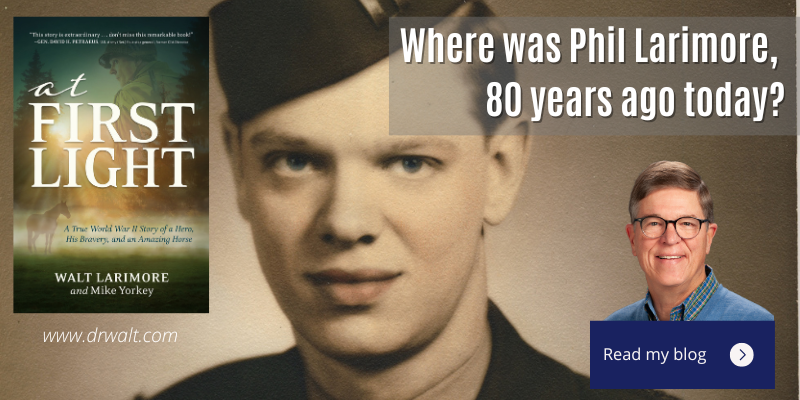
February 20, 1944 – A teenage WWII hero arrives at his new unit on Anzio
February 20, 2024
February 22, 1944 – A teenage WWII hero meets his A&P platoon
February 22, 2024In the middle of February, the weather turned rainy, and the wind was sharp and ice-cold. Phil and the other men were a miserable bunch, and they hadn’t even reached the front yet. The incessant shelling and artillery only compounded the men’s misery.

Into No Man’s Land
“The first time a man goes into battle is strangely like the first time a man makes love to a woman.
The anticipation is overpowering; the ignorance is obstructive;
the fear of disgrace is consuming; and survival is triumphant.”
—Ben Bradlee, World War II veteran and executive editor of The Washington Post from 1965–1991
When Phil and the other replacements arrived at the 3rd Battalion (30th Infantry Regiment, 3rd Infantry Division) command post, a small stone farmhouse in the Italian countryside, the only thing colder than the weather were the looks cast at them by the enlisted men surrounding the building.
One of the replacements observed, “They didn’t say much when we came in, clean and shiny with our new overcoats, packs, and helmets. They just looked at us.”
The enlisted men were led off, and seventeen new officers were invited inside a small barn on the property attached to the main house. The windows were blacked out with army blankets, and a Coleman lantern[1] lit the barn.
Captain Robert M. Boddy, the battalion S-3 who was the officer in charge of operations, training, and various other responsibilities, walked into the barn and introduced himself. No sooner had he shaken a few hands than a medic arrived and started dispensing morphine syrettes to each of the men with an explanation on how to use them.
“You may get to your casualties before we do,” the medic began. “It’s like a syringe, except it has a squishable, collapsible container, kinda like toothpaste. After the injection, pin the used tube to the soldier’s collar to inform others of the dose administered. Don’t be afraid to use them. We’ve got plenty more where these came from.”
At that moment, 3rd Battalion Commander Major Allen F. Bacon, who had taken over command on February 20, strode in. The men all popped to attention. He had them sit while he pulled up a chair.
“Men, we’ve been assigned to what the brass is calling an ‘aggressive defensive strategy.’ We’re to hold our sector of the beachhead against a relentless and determined enemy. We’ll be continually patrolling and raiding, all the while expecting persistent strong enemy armor-supported attacks. We expect enemy air activity to be intense—heavy bombing and occasional strafing. At night, we won’t rest. We’ll have reconnaissance and combat patrols probing the enemy positions, and we’ll be ordered into sporadic attacks involving artillery and tank destroyer[2] fire support. This will be made all the more difficult as the Germans are well dug in and camouflaged, defending the key positions in their outer defense line with deadly automatic weapons fire.”[3]
He let his difficult words sink in and then continued. “Let me be clear. We’re fighting for our lives on this flat, shell-swept beachhead. Ten battalions from seven German divisions occupy an iron ring on our perimeter and hammer us relentlessly. Many of our men are in water-filled foxholes for days on end, afraid to let the tops of their helmets show at all. Casualties have been dangerously high.”
Major Bacon leaned back in his chair, then leaned forward. “But know this. This battalion will not stay bogged down. We’re in Corps Reserve right now, but I’m expecting to be placed on alert status at any moment. And then, when the time comes, we’ll break out. And we’ll kick butt. And each of you”—he slowly looked at each officer—“will make that happen. I look forward to serving with you.”
After the major left, Captain Boddy handed out the assignments, saying that guides would take them up to their companies. He looked at Russell Cloer. “Your assignment is platoon leader of the I&R Platoon.”[4]
Then he turned to Phil. “Your assignment is platoon leader for the A&P Platoon.[5] Across the road is another house. Your non-coms are over there. Walk across the road, and they’ll tell you what you’re supposed to do.”
That was it. The captain then pronounced, “Dismissed.”
Phil blinked as he walked out into the bright daylight. It took a few seconds for his eyes to adjust. Then he received a welcome surprise.
“Son of a bitch!” was all he could gasp as he recognized the man waiting for him with an East Tennessee smile spreading from ear-to-ear.
“Welcome to Anzio, you son of a bitch, you!” exclaimed Ross Calvert, his good buddy from OCS training. The two men embraced, laughing and slapping each other’s backs. “We can catch up later, Phil. Let me get you to your men because you’ve got one hell of an assignment. Mind if I give you some advice?”
“Not at all.”
Ross took out a pack of cigarettes and offered one to Phil. They lit up, and after a puff, Ross said, “You’ve got some amazing guys serving under you. They’ll be the warhorses you and I have talked so much about. A lot of them are what we call ‘old men,’ meaning they’ve been with the unit since French Morocco. Their last 2nd lieutenant was a ninety-day-wonder[6] who was an obnoxious, self-centered, know-it-all asshole. Hadn’t been in the company two or three days when he got his head blown off ’cause he didn’t listen to his men. He was a dumbass. I know you won’t be. But you need to know these good men need—no—deserve a hell of a leader.”
“Thanks, Ross. I really appreciate the head’s up.”
[1] Small, portable lanterns made by the Coleman company were declared an “essential item” for troops serving in World War II. Nearly 70,000 lanterns were distributed for use by the GIs fighting in Europe.
[2] A tank destroyer (TD), a highly mobile lightly armored tank-type vehicle used to fight tanks in World War II, had thick front armor, relatively thin armor on the sides and in the rear, and a long-barreled, high-velocity gun capable of outranging enemy tanks.
[3] An automatic firearm is a firearm capable of automatically cycling the shooting process without needing any more manual operation from the user than simply keeping a trigger depressed. Examples include machine pistols, submachine guns, and machine guns.
[4] An I&R or Intelligence and Reconnaissance Platoon was typically led by a junior officer (a 1st lieutenant), a sergeant to assist him, and a driver for the Platoon Jeep. There were another eighteen Infantrymen. They collected, evaluated, and disseminated information under the supervision of the regimental intelligence officer (S-2). The platoon also carried out counterintelligence measures and surveillance.
[5] The Ammunition and Pioneer Platoon and its men, called “sappers,” had to transport ammunition from the rear to the frontline soldiers. The A&P platoon also had frontline pioneer or combat engineer duties, such as preparing and strengthening field defenses and fortifications by laying defensive wire and mines, as well as clearing enemy minefields.
[6] A “ninety-day wonder” was a derogatory term for recently commissioned graduates of the three-month-long Officer Candidate School at Fort Benning, Georgia.
In case you haven’t read or listened to Dad’s book, you can learn more or order it here.
© Copyright WLL, INC. 2024.



